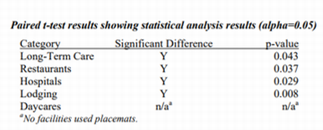Executive Summary:
A Study of Reusable and Single-Use Foodservice Items
Conducted for the Foodservice Packaging Institute, Inc. by Silliker, Inc. Food Science Center
September 2012
INTRODUCTION & METHODOLOGY
From December 2011 to April 2012 the Foodservice Packaging Institute, Inc., with the assistance of Sacramento County, California Health Department, conducted a survey of the sanitary quality of single-use foodservice packaging products and their reusable counterparts. Four health inspectors visited 30 different foodservice establishments including coffee bars, restaurants and colleges/universities. In each establishment, five single-use and five reusable foodservice items were sampled using a swab test protocol developed by Silliker, Inc. of Chicago, Illinois, for a study sample size of 300 items. Samples included forks, knives, spoons, cups, containers, plates and bowls.
One sterile transport swab containing a medium to prevent die off of microorganisms was used to sample each foodservice item. The swab was rubbed slowly and thoroughly over the entire food contact surface area and returned to its transport vial for shipment. Vials were packed in ice and shipped to Silliker’s Food Science Center for testing.
Once returned, each swab was tested utilizing standard methodology for aerobic plate count, staphylococcus plate count, enterococcus plate count and coliform most probable number technique. All bacterial counts were converted into logarithms for data analysis. If p>0.05, no statistically significant difference was detected.
RESULTS
All Enterococcus and Coagulase Positive Staphylococcus (CPS) plate counts were below the detection limit of the analyses. Significant differences (p=0.0043) were observed statistically for single-use versus their reusable counterparts for the aerobic plate count (APC). Significant differences (p=0.045) were observed statistically for single-use versus their reusable counterparts for coliform count.
CONCLUSION
Overall, reusable foodservice items had higher microbial levels than single-use foodservice items. This difference could be attributed to handling of reusable items more frequently by food service employees versus single-use items, or insufficient cleaning and sanitizing of reusable foodservice items.
The full report is available for members of the Foodservice Packaging Institute


